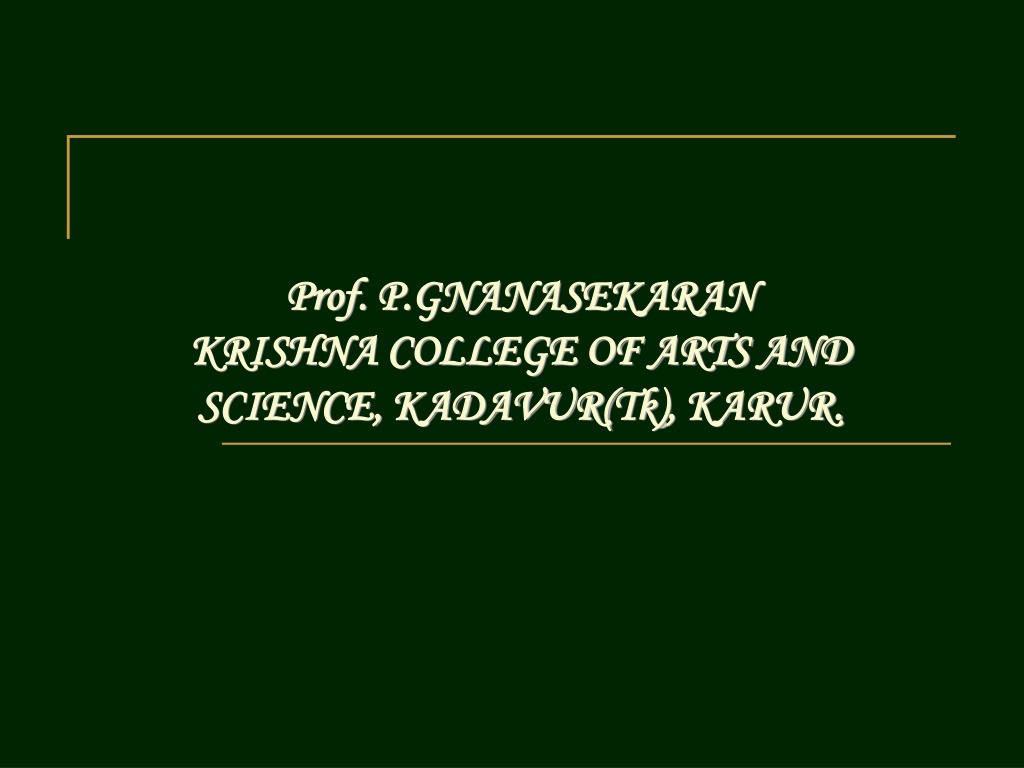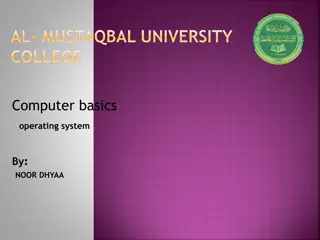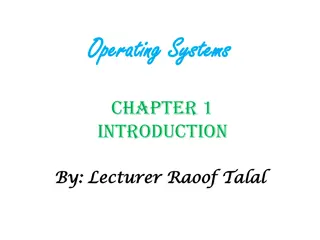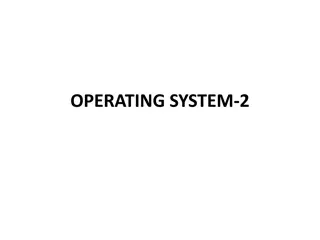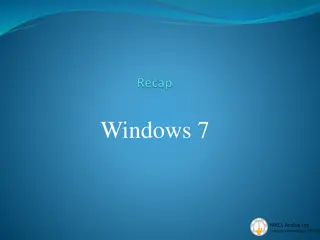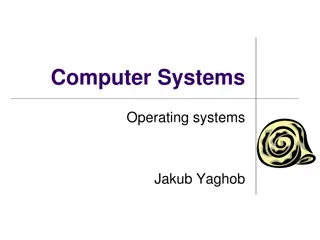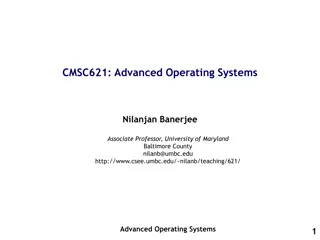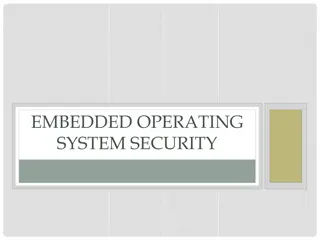Understanding Operating Systems: Functions and Evolution
Operating systems are essential software that enable computers to function effectively by managing hardware resources and facilitating communication between applications and hardware. This article covers the basics of operating systems, their structure, evolution, functions, and types. It also explores application software like Database Management Systems, Spreadsheets, and Graphic Presentations. Examples and uses of different software tools are discussed to provide a comprehensive overview of operating systems and application software.
Download Presentation

Please find below an Image/Link to download the presentation.
The content on the website is provided AS IS for your information and personal use only. It may not be sold, licensed, or shared on other websites without obtaining consent from the author. Download presentation by click this link. If you encounter any issues during the download, it is possible that the publisher has removed the file from their server.
E N D
Presentation Transcript
Prof. P.GNANASEKARAN Prof. P.GNANASEKARAN KRISHNA COLLEGE OF ARTS AND KRISHNA COLLEGE OF ARTS AND SCIENCE, KADAVUR( SCIENCE, KADAVUR(Tk Tk), KARUR. ), KARUR.
Operating Systems Operating Systems
Contents Topics: 1. What is Operating System? 2. What OS does? 3. Structure of OS 4. Evolution of OS Batch Processing, Multiprogramming, Time sharing systems 5. Operating System Functions 6. Main Functions of OS 7. Types of OS Single User, Multi User systems
Application Software (contd ): Database Management System (DBMS): A DBMS is a software tool that allows multiple users to store, access, and process data into useful information. Database programs are designed for these types of applications: Membership lists Student lists Grade reports Instructor schedules All of these have to be maintained so you can find what you need quickly and accurately. Example:Microsoft Access, dBASE, Oracle.
Application Software (contd ): Spreadsheets: The spreadsheet packages are designed to use numbers and formulas to do calculations with ease. Examples of spreadsheets include: Budgets Payrolls Grade Calculations Address Lists The most commonly used spreadsheet programs are Microsoft Excel and Lotus 123.
Application Software (contd ): Graphic Presentations: The presentation programs can be easier using overhead projectors. Other uses include: Slide Shows Repeating Computer Presentations on a computer monitor Using Sound and animation in slide shows The most recognized graphic presentation programs are Microsoft PowerPoint and Harvard Graphics.
What is OS? Operating System is a software, which makes a computer to actually work. It is the software the enables all the programs we use. The OS organizes and controls the hardware. OS acts as an interface between the application programs and the machine hardware. Examples: Windows, Linux, Unix and Mac OS, etc.,
What OS does? An operating system performs basic tasks such as, controlling and allocating memory, prioritizing system requests, controlling input and output devices, facilitating networking and managing file systems.
Structure of Operating System: Application Programs System Programs Software (Operating System) HARDWARE (Contd )
Structure of Operating System (Contd ): The structure of OS consists of 4 layers: 1. Hardware Hardware consists of CPU, Main memory, I/O Devices, etc, 2. Software (Operating System) Software includes process management routines, memory management routines, I/O control routines, file management routines. (Contd )
Structure of Operating System (Contd ): 3. System programs This layer consists of compilers, Assemblers, linker etc. 4. Application programs This is dependent on users need. Ex. Railway reservation system, Bank database management etc.,
Evolution of OS: The evolution of operating systems went through seven major phases. Six of them significantly changed the ways in which users accessed computers through the open shop, batch processing, multiprogramming, timesharing, personal computing, and distributed systems. In the seventh phase the foundations of concurrent programming were developed and demonstrated in model operating systems. (Contd )
Evolution of OS (contd..): Major Phases Innovations Technical Operating Systems The idea of OS IBM 701 open shop (1954) Open Shop Tape batching, First-in, first-out scheduling. BKS system (1961) Batch Processing Processor multiplexing, Indivisible operations, Demand paging, Input/output spooling, Priority scheduling, Remote job entry Atlas supervisor (1961), Exec II system (1966) Multi- programming (Contd )
Evolution of OS (contd..): Simultaneous user interaction, On-line file systems Multics file system (1965), Unix (1974) Timesharing Hierarchical systems, Extensible kernels, Parallel programming concepts, Secure parallel languages RC 4000 system (1969), 13 Venus system (1972), 14 Boss 2 system (1975). OS 6 (1972) Pilot system (1980) Concurrent Programming Graphic user interfaces Personal Computing Distributed Systems Remote servers WFS file server (1979) Unix United RPC (1982) 24 Amoeba system (1990)
Batch Processing: In Batch processing same type of jobs batch (BATCH- a set of jobs with similar needs) together and execute at a time. The OS was simple, its major task was to transfer control from one job to the next. The job was submitted to the computer operator in form of punch cards. At some later time the output appeared. The OS was always resident in memory. (Ref. Fig. next slide) Common Input devices were card readers and tape drives.
Batch Processing (Contd): Common output devices were line printers, tape drives, and card punches. Users did not interact directly with the computer systems, but he prepared a job (comprising of the program, the data, & some control information). OS User program area
Multiprogramming: Multiprogramming is a technique to execute number of programs simultaneously by a single processor. In Multiprogramming, number of processes reside in main memory at a time. The OS picks and begins to executes one of the jobs in the main memory. If any I/O wait happened in a process, then CPU switches from that job to another job. Hence CPU in not idle at any time.
Multiprogramming (Contd): OS Figure dipicts the layout of multiprogramming system. Job 1 The main memory consists of 5 jobs at a time, the CPU executes one by one. Job 2 Job 3 Advantages: Job 4 Efficient memory utilization Throughput increases Job 5 CPU is never idle, so performance increases.
Time Sharing Systems: Time sharing, or multitasking, is a logical extension of multiprogramming. Multiple jobs are executed by switching the CPU between them. In this, the CPU time is shared by different processes, so it is called as Time sharing Systems . Time slice is defined by the OS, for sharing CPU time between processes. Examples: Multics, Unix, etc.,
Operating Systems functions: The main functions of operating systems are: 1. Program creation 2. Program execution 3. Input/Output operations 4. Error detection 5. Resource allocation 6. Accounting 7. protection
Types of OS: Operating System can also be classified as,- Single User Systems Multi User Systems
Single User Systems: Provides a platform for only one user at a time. They are popularly associated with Desk Top operating system which run on standalone systems where no user accounts are required. Example: DOS
Multi-User Systems: Provides regulated access for a number of users by maintaining a database of known users. Refers to computer systems that support two or more simultaneous users. Another term for multi-user is time sharing. Ex: All mainframes and are multi-user systems. Example: Unix
